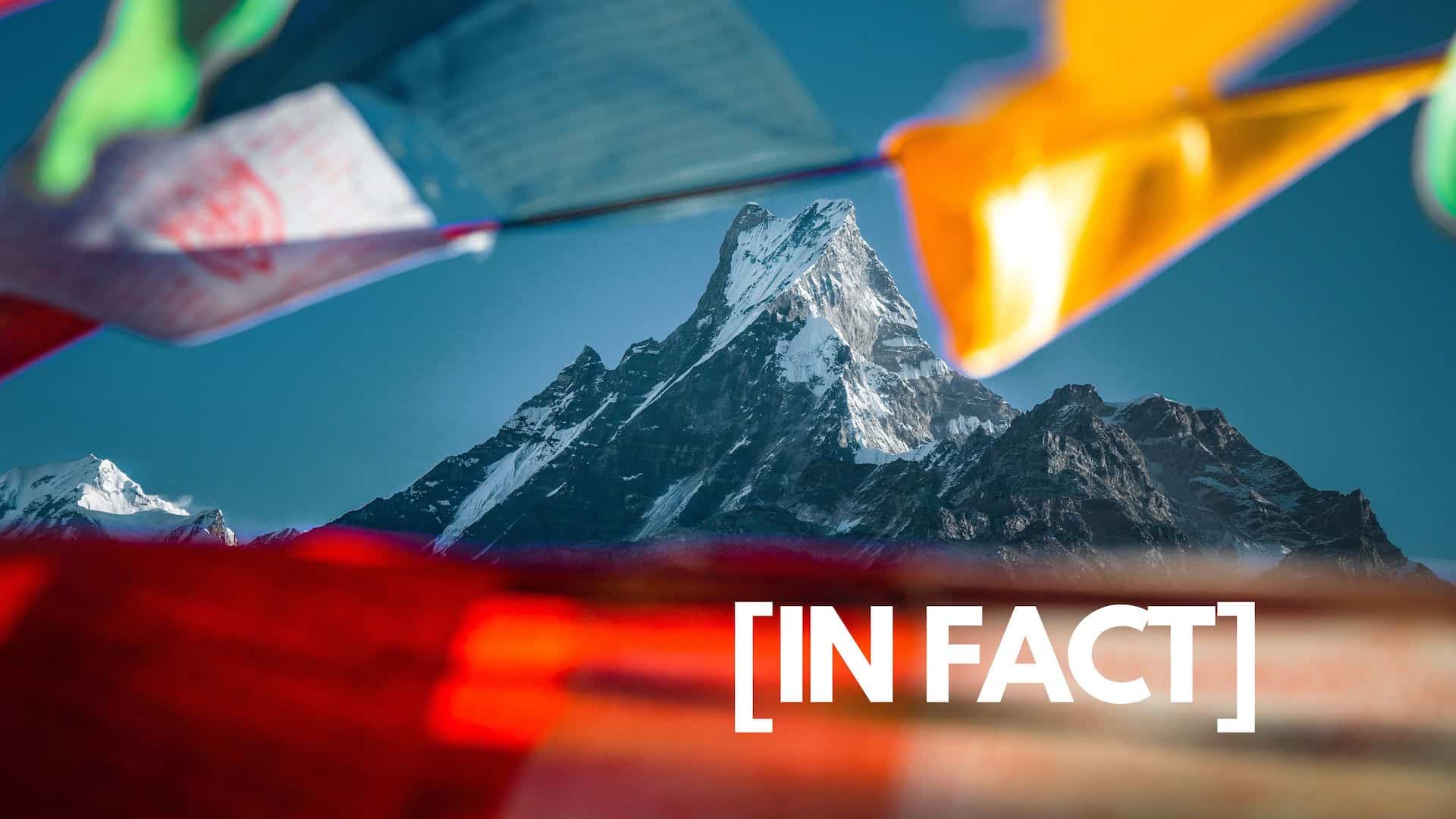
30 Mind-blowing Facts About Mount Everest That Will Amaze You
Did you know that Mount Everest is not only the highest mountain in the world but also the most expensive one to climb? Or that it has its own microclimate, where it can snow even in summer? Or that it is home to some of the rarest and most endangered animals on Earth? These are just some of the mind-blowing facts about Mount Everest that you will discover in this article. Mount Everest is a fascinating and mysterious place that has captivated the imagination of explorers, adventurers, and dreamers for centuries. It is also a place of extreme beauty, danger, and challenge that tests the limits of human endurance and courage.
In this article, we will reveal 30 amazing facts about Mount Everest that will make you appreciate this majestic mountain even more. Whether you are a fan of mountaineering, geography, history, or culture, you will find something interesting and surprising in this article. So, get ready to embark on an incredible journey to the roof of the world and learn some mind-blowing facts about Mount Everest.
30 Mind-blowing Facts About Mount Everest
Let’s learn more about Mount Everest from the facts in different aspects that significantly amaze you!
A. Geography
Mount Everest is part of the Himalayas, the highest mountain range in the world. The Himalayas stretch across six countries: Nepal, China, India, Bhutan, Pakistan, and Afghanistan. Mount Everest is located on the border between Nepal and Tibet, an autonomous region of China. The height of Mount Everest is constantly changing due to tectonic movements and glacial melting. The current official height of Mount Everest is 8,848.86 meters (29,031.7 feet), which was measured by a joint survey team from Nepal and China in 2020. However, some sources claim that the height of Mount Everest is slightly higher or lower than that. Mount Everest has several features that make it unique and challenging for climbers. Some of these features are:
1. The Summit
The summit of Mount Everest is the highest point on Earth. It is also the coldest, windiest, and driest place on the planet. The temperature at the summit can drop to -60°C (-76°F) and the wind speed can reach up to 320 km/h (200 mph). The air pressure at the summit is only about one-third of that at sea level, which means that there is less oxygen available for breathing. The summit of Mount Everest is covered by snow and ice all year round, except for a few days in summer when some rocks are exposed.
2. The Base Camps
The base camps are the places where climbers set up their tents and equipment before attempting to reach the summit. There are two main base camps on opposite sides of Mount Everest: the south base camp in Nepal and the north base camp in Tibet. The south base camp is located at an altitude of 5,364 meters (17,598 feet) and the north base camp is located at an altitude of 5,150 meters (16,900 feet). Both base camps are accessible by road or helicopter. Yet, they are still very remote and isolated from civilization.
3. The Khumbu Icefall
The Khumbu Icefall is one of the most dangerous sections of the climb from the south base camp to the summit. It is a steep and unstable glacier that moves constantly and creates huge crevasses and ice blocks that can collapse at any time. Climbers have to cross the Khumbu Icefall using ladders, ropes, and crampons. The Khumbu Icefall is also known as the “popcorn field” because of the sound of ice cracking and falling.
4. The Death Zone
The death zone is the area above 8,000 meters (26,247 feet) where the oxygen level is so low that it cannot sustain human life for long. Most of the deaths on Mount Everest occur in the death zone due to exhaustion, hypothermia, frostbite, or altitude sickness. Climbers have to use supplemental oxygen to survive in the death zone, but even that may not be enough to prevent fatal complications. The death zone is also where most of the bodies of deceased climbers are left behind, as it is too difficult and dangerous to bring them down.
B. Climate
Mount Everest has extreme weather conditions that vary depending on the season, altitude, and location. The climate of Mount Everest is influenced by two main factors: the jet stream and the monsoon.
- The jet stream is a high-speed wind that blows from west to east around the globe. It affects the weather on Mount Everest by creating strong winds, storms, and clouds that can obscure visibility and make climbing more difficult.
- The monsoon is a seasonal wind that brings heavy rain and snow to the Himalayas from June to September. It affects the weather on Mount Everest by increasing precipitation, humidity, and temperature which can cause avalanches, landslides, and floods.
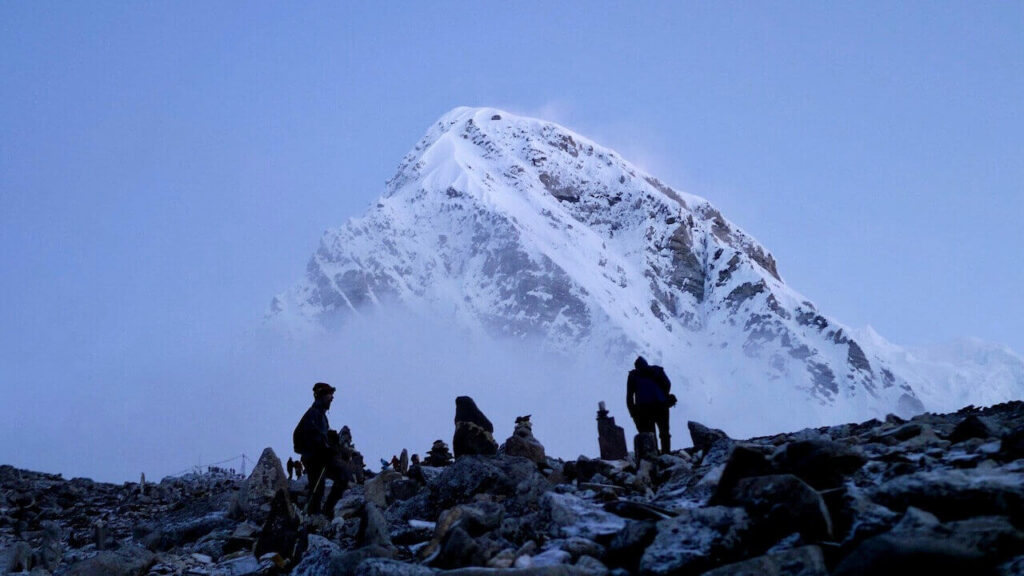
The best time to climb Mount Everest is usually in spring (April-May) or autumn (September-October), when the weather is more stable and clear. However, there is no guarantee that the weather will be favorable at any time of the year. Some of the natural phenomena that occur on Mount Everest are:
5. Snow
Snow falls on Mount Everest throughout the year. Even, it’s more frequent and heavily during winter and monsoon seasons. Snow can accumulate up to several meters deep on some parts of the mountain. Yet, it creates beautiful scenery on Mount Everest, such as snowflakes, snowflake patterns, snow sculptures, and snow bridges. Snow can also pose many hazards on Mount Everest, such as blizzards, whiteouts, snow blindness, and frostbite.
6. Clouds
Clouds form on Mount Everest when warm moist air rises and cools down in higher altitudes. It can create different effects on Mount Everest, such as fog, mist, haze, and rainbows. Additionally, clouds can create spectacular views of Mount Everest, such as cloud forests, cloud seas, cloud caps, and cloud inversions. Clouds can also cause many problems on Mount Everest, such as reduced visibility, increased humidity, and decreased temperature.
7. Avalanches
Avalanches are sudden and rapid movements of snow or ice down a slope. In fact, various factors, such as wind, snowfall, temperature, slope angle, and human activity can trigger avalanches. Avalanches can occur on any part of Mount Everest, but more frequently and violently on the western and northern slopes. Significantly, avalanches can be very destructive and deadly on Mount Everest, as they can bury, crush, or sweep away anything in their path.
C. Wildlife
Mount Everest is home to a variety of animals and plants that have adapted to the harsh environment. Some of these organisms are endemic. In other words, you can find them nowhere else in the world. Some of these organisms are at risk of extinction due to human activities or natural causes. In this part of the mind-blowing facts about Mount Everest, we will learn about some of the species that live on or near Mount Everest:
8. Snow Leopards
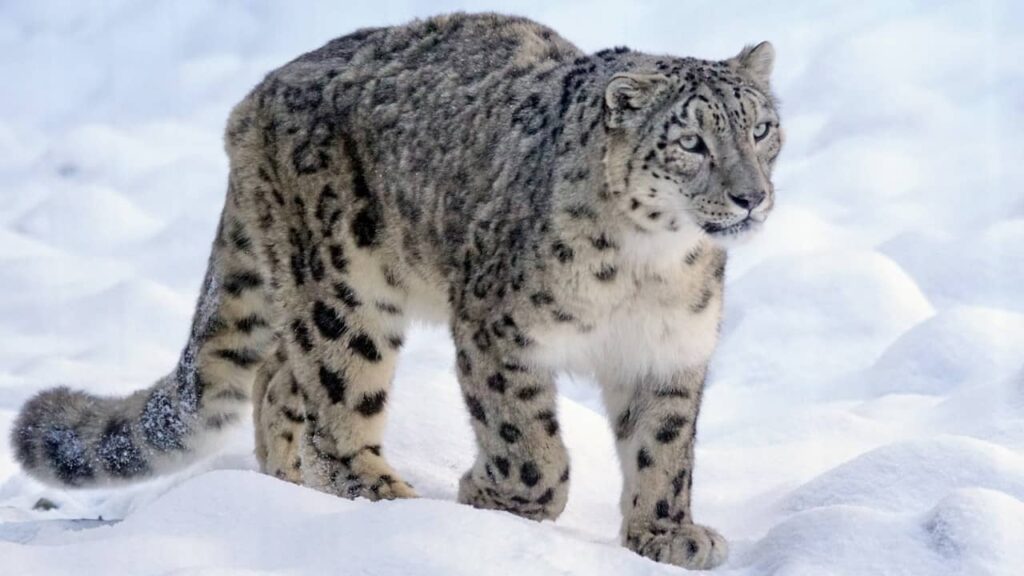
Snow leopards are large cats that live in the high mountains of Central and South Asia. They have thick fur, long tails, and powerful legs that help them survive in the cold and rugged terrain. Also, they are able to leap up to 15 meters (50 feet) in a single bound. Snow leopards are elusive and solitary animals that hunt mostly at dawn and dusk. They feed on prey such as blue sheep, ibex, marmots, and hares. Snow leopards are threatened by poaching, habitat loss, and climate change. They are estimated to number between 4,000 and 6,500 in the wild.
9. Red Pandas
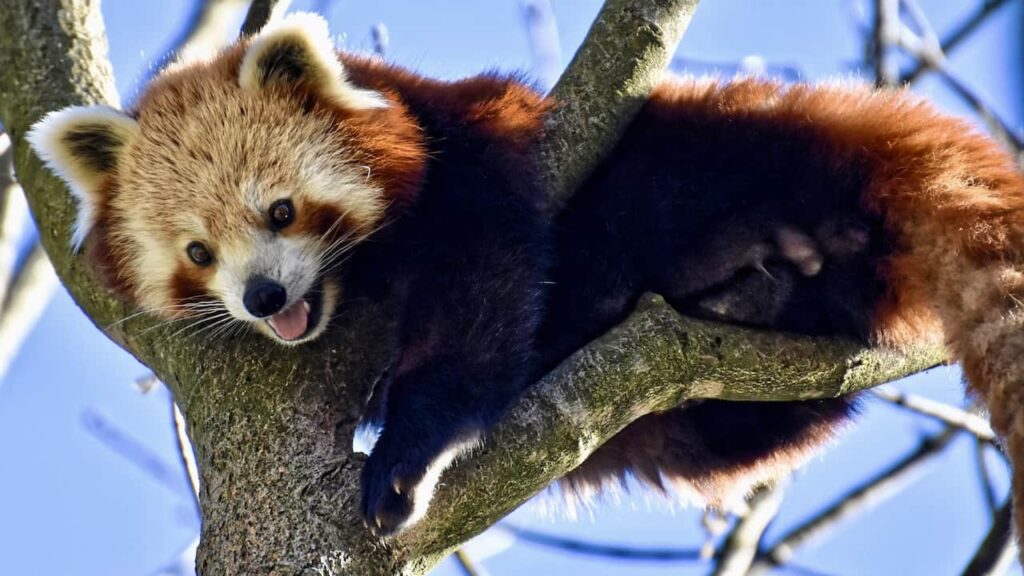
Red pandas are small mammals that live in the temperate forests of the Himalayas. They have reddish-brown fur, black-and-white markings, and bushy tails that help them blend in with their surroundings. They are also able to climb trees and use their tails as blankets. Red pandas are mostly active at night and feed on bamboo, fruits, nuts, and eggs. Red pandas are endangered by deforestation, hunting, and disease. The estimation of red pandas in the wild is between 10,000 and 20,000.
10. Himalayan Black Bears
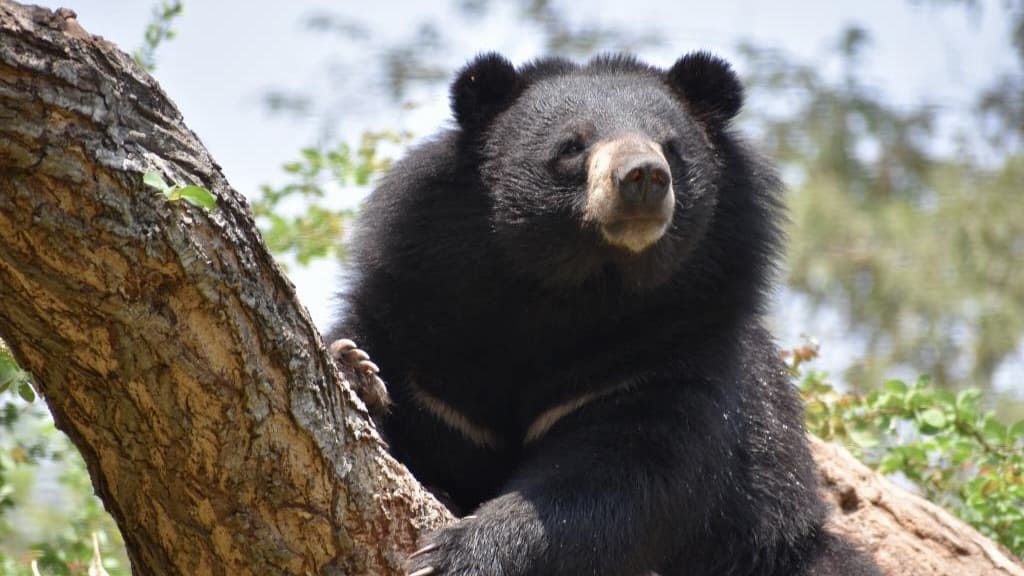
Himalayan black bears are medium-sized bears that live in the forests and alpine meadows of the Himalayas. They have black fur, white chest patches, and brown muzzles that distinguish them from other bears. They are also able to hibernate during winter and store fat in their bodies. Himalayan black bears are omnivorous and feed on plants, insects, honey, rodents, and carrion. Himalayan black bears are vulnerable to habitat loss, poaching, and human-wildlife conflict. They are estimated to number between 6,000 and 12,000 in the wild.
11. Yaks
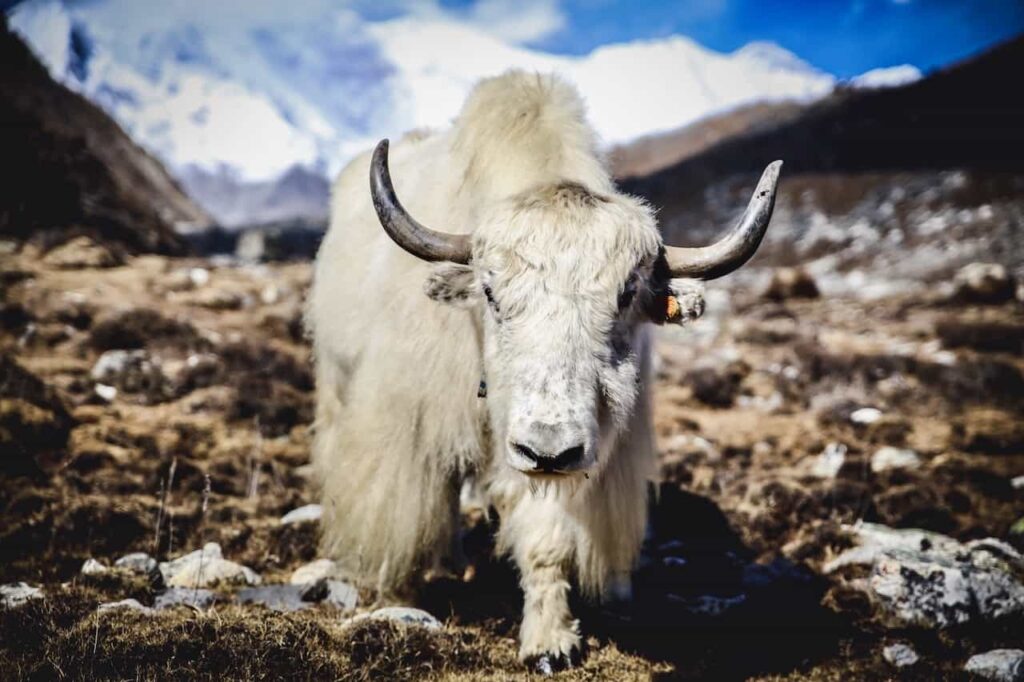
Yaks are large bovids that live in the high plateaus and grasslands of the Himalayas. They have long hair, curved horns, and hooves that help them cope with the cold and rough terrain. They are also able to produce milk, meat, wool, and leather which are valuable for humans. Yaks are domesticated by local people who use them for transportation, farming, and trade. Yaks are herbivorous and feed on grasses, shrubs, lichens, and mosses. Fortunately, these animals are not endangered but face threats from overgrazing, disease, and hybridization with cattle.
12. Rhododendrons
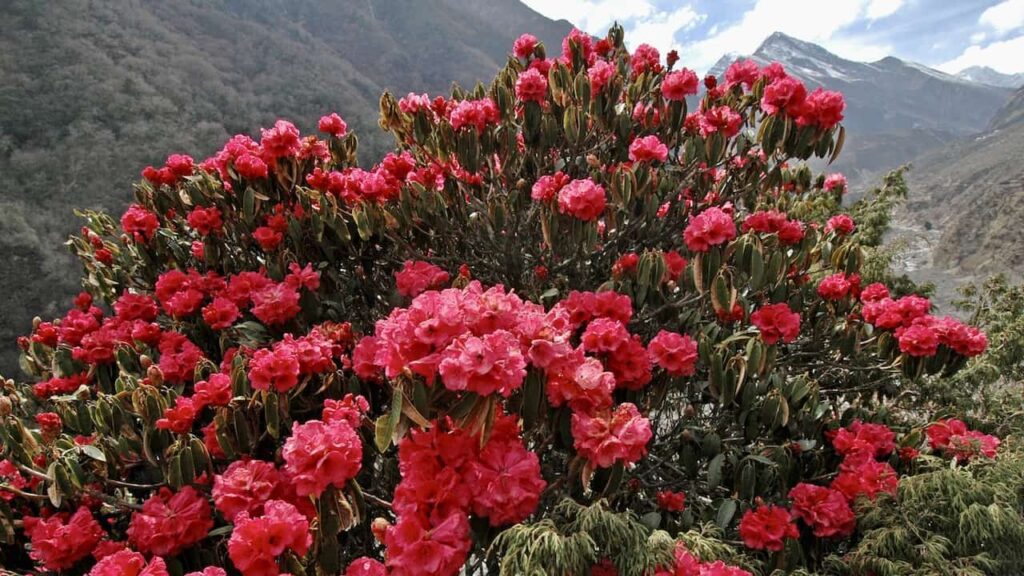
Rhododendrons are flowering plants that grow in the forests and slopes of the Himalayas. They have colorful flowers, evergreen leaves, and woody stems that make them attractive and durable. They are also able to bloom even in snow and frost conditions. Rhododendrons are diverse and have over 1,000 species that vary in size, shape, color, and fragrance. They are pollinated by insects, birds, and mammals that visit their flowers. Rhododendrons are not threatened but face challenges from climate change, invasive species, and human disturbance.
D. Culture
Mount Everest is a sacred place for many people, especially the Sherpas and the Tibetans who live in the region.
13. The Sherpas and the Tibetans
13.1. The Sherpas
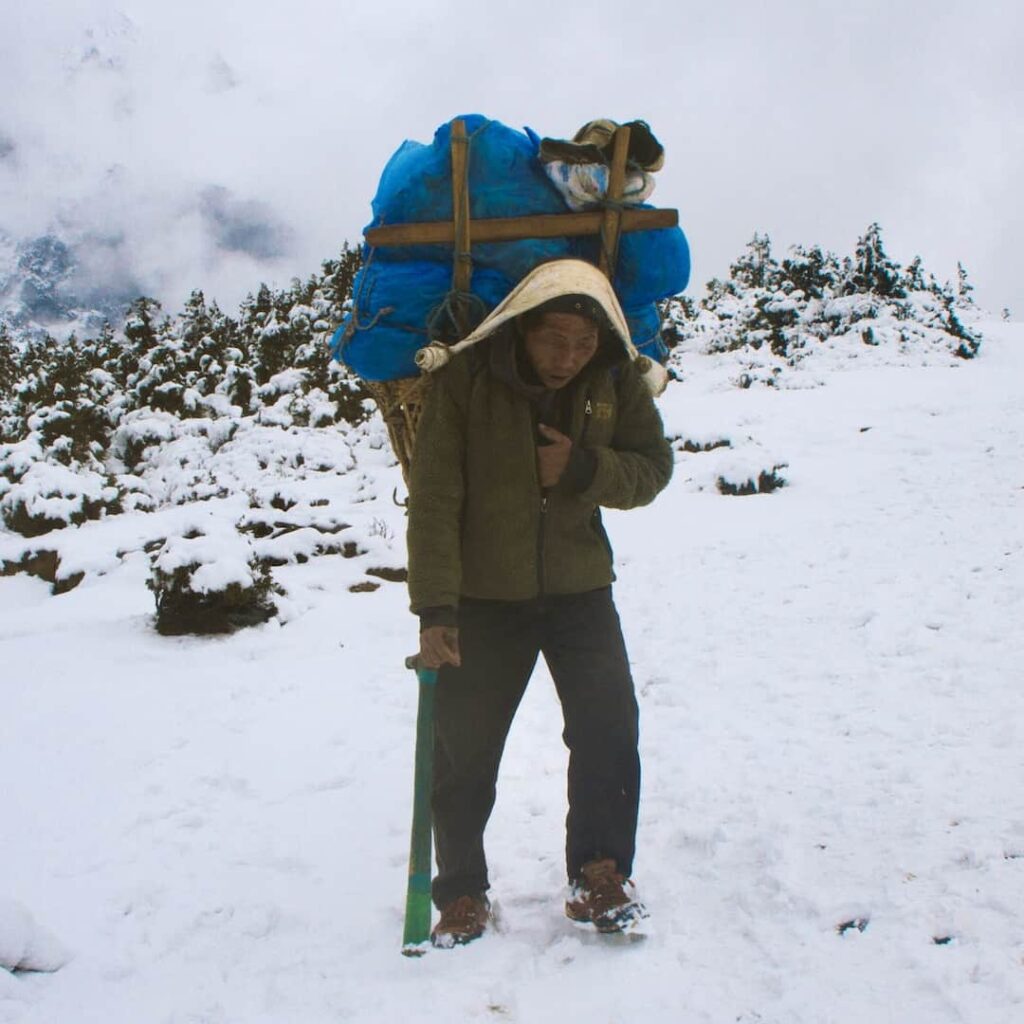
The Sherpas are an ethnic group of people who migrated from Tibet to Nepal centuries ago. They have a rich culture, language, religion, and tradition that are influenced by Buddhism. The Sherpas are renowned for their skills, knowledge, and courage as mountaineers, guides, porters, and rescuers on Mount Everest. The Sherpas regard Mount Everest as Chomolungma, which means “Goddess Mother of the World” in Tibetan. These people believe that Chomolungma is a living being that has a spirit, a personality, and a power that can affect the fate of climbers. They perform rituals, prayers, offerings, and respect to Chomolungma before attempting to climb her. Furthermore, the Sherpas have a legend that tells how Chomolungma was once a beautiful princess who was cursed by a jealous witch to become a mountain.
13.2. The Tibetans
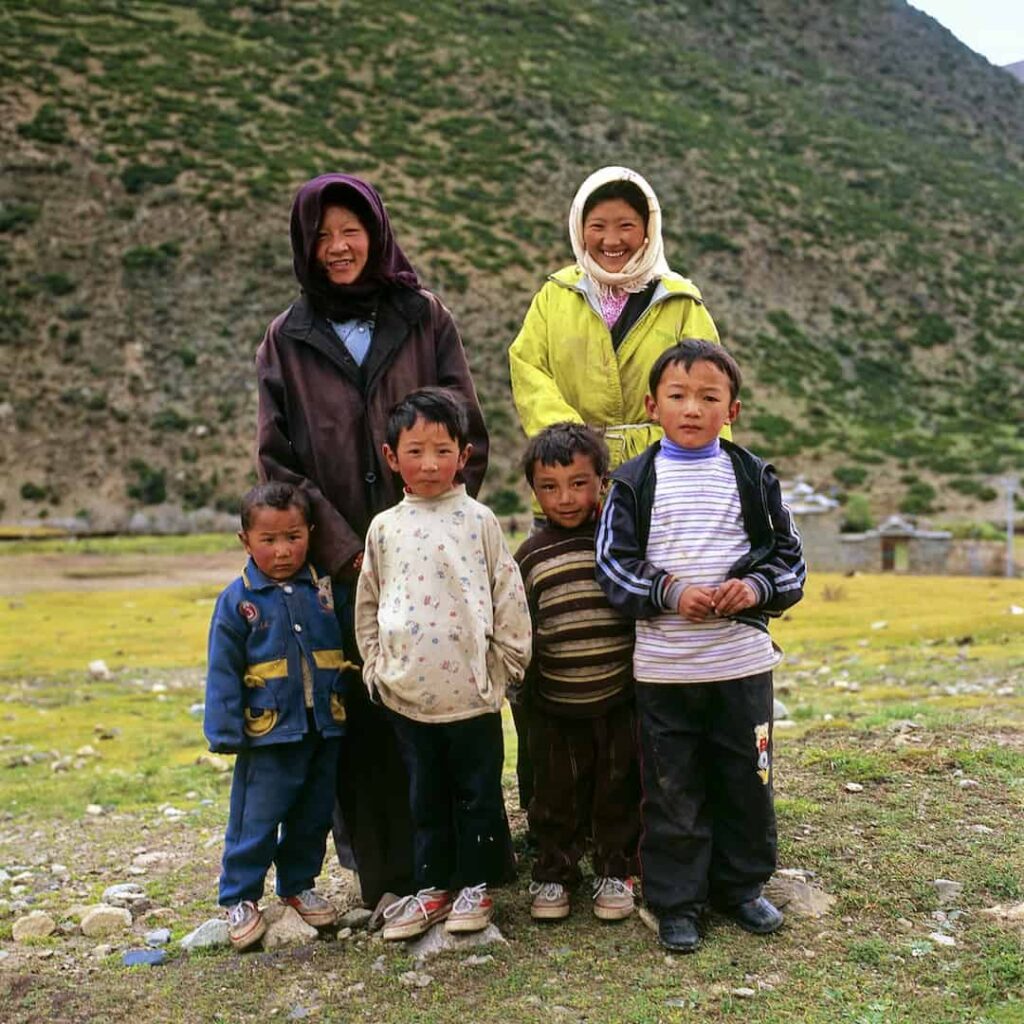
The Tibetans are an ethnic group of people who live in Tibet, an autonomous region of China. They have a rich culture, language, religion, and tradition that are influenced by Buddhism. The Tibetans regard Mount Everest as Zhumulangma Feng, which means “Goddess of the Turquoise Mountain” in Chinese. The Tibetans believe that Zhumulangma Feng is a holy mountain that is home to many deities, spirits, and ancestors who can grant blessings or curses to climbers. They perform rituals, prayers, offerings, and respect to Zhumulangma Feng before attempting to climb her. Moreover, the Tibetans have a legend that tells how Zhumulangma Feng was once a goddess who fell in love with a mortal man and gave birth to the first Tibetan king.
Mount Everest has also had a cultural impact on the world, as it has inspired many forms of art, literature, and films that depict its beauty, mystery, and challenge. Some of the examples are:
14. Art
Mount Everest has been painted by many artists who have captured its scenery, colors, and mood in different styles and techniques. Some of the famous paintings of Mount Everest are: “Mount Everest from the Rongbuk Monastery” by Nicholas Roerich in 1928, “Mount Everest from Kala Pattar” by John Singer Sargent in 1931, “Mount Everest from Gokyo Ri” by Stephen Venables in 1988, and “Mount Everest from Space” by Michael Benson in 2004.
15. Literature
Mount Everest has been written about by many writers who have described its history, stories, and emotions in different genres and formats. Some of the famous books about Mount Everest are: “The Conquest of Everest” by John Hunt in 1954, “Into Thin Air” by Jon Krakauer in 1997, “Peak” by Roland Smith in 2007, and “The Abominable” by Dan Simmons in 2013.
16. Films
Mount Everest has been filmed by many filmmakers who have portrayed its drama, adventure, and spectacle in different perspectives and techniques. Some of the famous movies about Mount Everest are: “The Epic of Everest” by John Noel in 1924, “The Man Who Skied Down Everest” by Bruce Nyznik and Lawrence Schiller in 1975, “Everest” by Baltasar Kormákur in 2015, and “Free Solo” by Jimmy Chin and Elizabeth Chai Vasarhelyi in 2018.
E. History
Mount Everest has a long and rich history of exploration and discovery that spans over two centuries. It has witnessed many milestones and achievements that have marked the human quest for knowledge, adventure, and glory. It has also witnessed many challenges and tragedies that have tested the human limits of endurance, courage, and survival. Some of the historical events that have occurred on Mount Everest are:
17. The First Survey
The British-led Great Trigonometrical Survey of India conducted the first survey of Mount Everest in the early 1800s. The surveyors used trigonometry, astronomy, and mathematics to measure the heights and distances of the Himalayan peaks. They named Mount Everest after Sir George Everest, the surveyor-general of India at the time. However, they did not know that Mount Everest was the highest mountain in the world until 1856 when they confirmed its height as 8,840 meters (29,002 feet).
18. The First Attempt
A British-led expedition made the first attempt to climb Mount Everest in 1921. The expedition was led by Charles Howard-Bury, a veteran explorer and botanist. The expedition reached the north base camp in Tibet and explored the northern slopes of Mount Everest. They discovered the East Rongbuk Glacier, the North Col, and the Northeast Ridge. In addition, they encountered some difficulties, such as altitude sickness, bad weather, and political unrest. They reached an altitude of 7,007 meters (22,985 feet) but had to turn back due to a lack of time and resources.
19. The First Ascent
The first ascent of Mount Everest was achieved by a British-led expedition in 1953. The expedition was led by John Hunt, a former army officer and mountaineer. The expedition used the south base camp in Nepal and followed the Southeast Ridge route. They faced many obstacles, such as icefalls, crevasses, storms, and avalanches. Besides that, they used supplemental oxygen, tents, radios, and cameras. They reached the summit on May 29, 1953, at 11:30 a.m. local time. The first two climbers to reach the summit were Edmund Hillary, a New Zealand beekeeper and mountaineer, and Tenzing Norgay, a Nepalese Sherpa guide and mountaineer. They spent about 15 minutes on the summit, taking photos, planting flags, etc.
F. Records
Mount Everest holds many records and statistics that are impressive and astonishing. It is the ultimate challenge and goal for many people who want to test their physical, mental, and emotional abilities. It is also the source of many feats and challenges that have been attempted or accomplished on Mount Everest. Some of the records that have been set or broken on Mount Everest are:
20. The Highest Altitude Reached by a Human Being
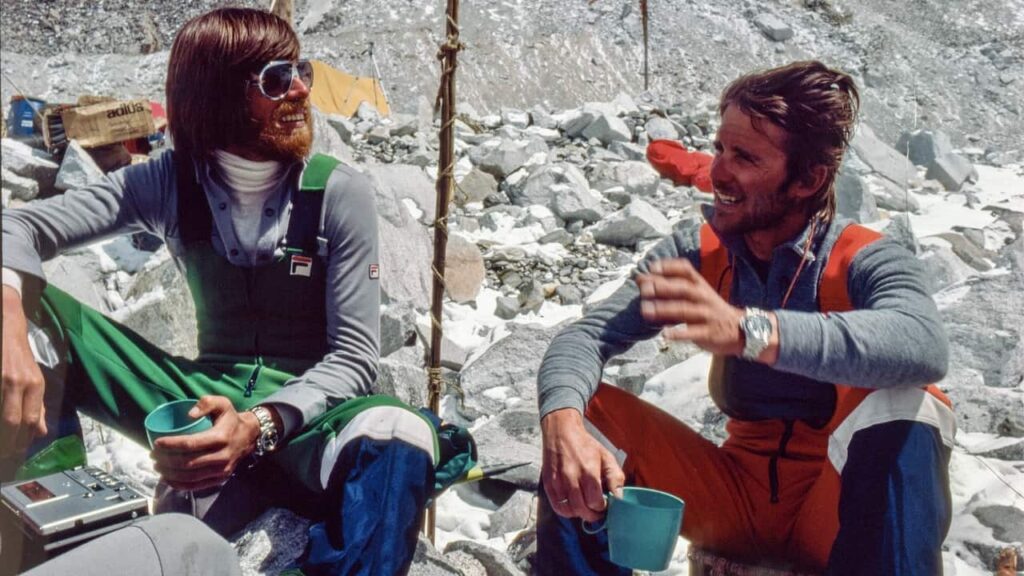
The highest altitude reached by a human being on Mount Everest is 8,848.86 meters (29,031.7 feet), which is the official height of the summit. However, some climbers have claimed to have reached higher points on Mount Everest, such as the top of a snow cornice or a rock pinnacle. The highest altitude reached by a human being without supplemental oxygen on Mount Everest is 8,848 meters (29,029 feet), which was achieved by Reinhold Messner and Peter Habeler in 1978.
21. The Youngest Person to Summit
The youngest person to summit Mount Everest is Kami Rita Sherpa, who was 13 years old when he reached the summit on May 22, 2010. He was accompanied by his father, Mingma Sherpa, who was also his guide. Kami Rita Sherpa is from Nepal and belongs to the Sherpa ethnic group. He started climbing at the age of nine and has climbed other peaks in the Himalayas.
22. The Oldest Person to Summit
The oldest person to summit Mount Everest is Yuichiro Miura, who was 80 years old when he reached the summit on May 23, 2013. He was accompanied by his son, Gota Miura, who was also his guide. Yuichiro Miura is from Japan and is a former ski instructor and adventurer. He has climbed Mount Everest three times, in 2003, 2008, and 2013. He also skied down from the South Col in 1970.
23. The Fastest Ascent
The fastest ascent of Mount Everest was by Lakpa Gelu Sherpa, who climbed from the south base camp to the summit in 8 hours and 10 minutes on May 26, 2003. He was accompanied by two other Sherpas, Pasang Tenzing Sherpa, and Mingma Tshering Sherpa, who were also his guides. Lakpa Gelu Sherpa is from Nepal and belongs to the Sherpa ethnic group. He has climbed Mount Everest more than 15 times and has set other speed records on other mountains.
24. The Most Ascents
The most ascents of Mount Everest are by Kami Rita Sherpa, who has climbed to the summit 25 times as of May 11, 2021. He is a professional guide and climber who works for Seven Summit Treks, a Nepalese company that organizes expeditions on Mount Everest. Kami Rita Sherpa is from Nepal and belongs to the Sherpa ethnic group. He started climbing at the age of 12 and has climbed other peaks in the Himalayas.
25. Skiing Down from the Summit
Skiing down from the summit of Mount Everest is one of the most daring and difficult feats that can be done on the mountain. It requires extreme skill, courage, and luck to navigate the steep slopes, crevasses, icefalls, and avalanches that lie between the summit and the base camp. Only a few people have successfully skied down from the summit of Mount Everest, such as Yuichiro Miura in 1970, Davo Karnicar in 2000, Kit DesLauriers in 2006, and Andrzej Bargiel in 2018.
26. Flying Over Mount Everest with a Jetpack
Flying over Mount Everest with a jetpack is one of the most adventurous and innovative feats that can be done on the mountain. It requires advanced technology, preparation, and coordination to fly over the summit with a jet-propelled device that can reach speeds of up to 300 km/h (186 mph). Only one person has successfully flown over Mount Everest with a jetpack, which was Yves Rossy in 2008. He flew for about eight minutes over the mountain, wearing a carbon-fiber wing with four jet engines attached to it.
27. Running a Marathon on Mount Everest
Running a marathon on Mount Everest is one of the most challenging and exhausting feats that can be done on the mountain. It requires immense stamina, endurance, and acclimatization to run for 42 km (26 miles) on a high-altitude course that starts at Gorak Shep (5,164 meters or 16,942 feet) near the south base camp and ends at Namche Bazaar (3,440 meters or 11,286 feet). The marathon is held every year on May 29, which marks the anniversary of the first ascent of Mount Everest. The fastest time for the marathon is 3 hours and 28 minutes, which was set by Phurba Tamang in 2017.
28. Paragliding from the Summit
Paragliding from the summit of Mount Everest is one of the most thrilling and spectacular feats that can be done on the mountain. It requires skill, courage, and luck to launch a paraglider from the summit and fly over the mountain scenery. It also requires a lot of planning, equipment, and support to make it possible. Only a few people have successfully paraglided from the summit of Mount Everest, such as Jean-Marc Boivin in 1988, Angelo d’Arrigo in 2004, Valery Rozov in 2013, and Babu Sunuwar and Lakpa Tsheri Sherpa in 2011.
29. Climbing without Supplemental Oxygen
Climbing without supplemental oxygen is one of the most difficult and dangerous feats that can be done on Mount Everest. It requires exceptional physical, mental, and emotional strength to climb without the aid of artificial oxygen in a low-oxygen environment. It also increases the risk of altitude sickness, hypothermia, frostbite, and death. Only about 200 people have successfully climbed Mount Everest without supplemental oxygen, such as Reinhold Messner and Peter Habeler in 1978, Anatoli Boukreev in 1996, and Kilian Jornet in 2017.
30. Climbing Solo
Climbing at Mount Everest is one of the most unique travel experiences around the world. On top of that, climbing solo is even one of the most challenging and lonely feats that can be done on Mount Everest. It requires independence, confidence, and self-reliance to climb without any partner, guide, or support team. It also exposes the climber to more dangers, such as accidents, injuries, illness, and isolation. Only about 50 people have successfully climbed Mount Everest solo, such as Reinhold Messner in 1980, Tomo Cesen in 1989, Hans Kammerlander in 1996, and Nirmal Purja in 2019.
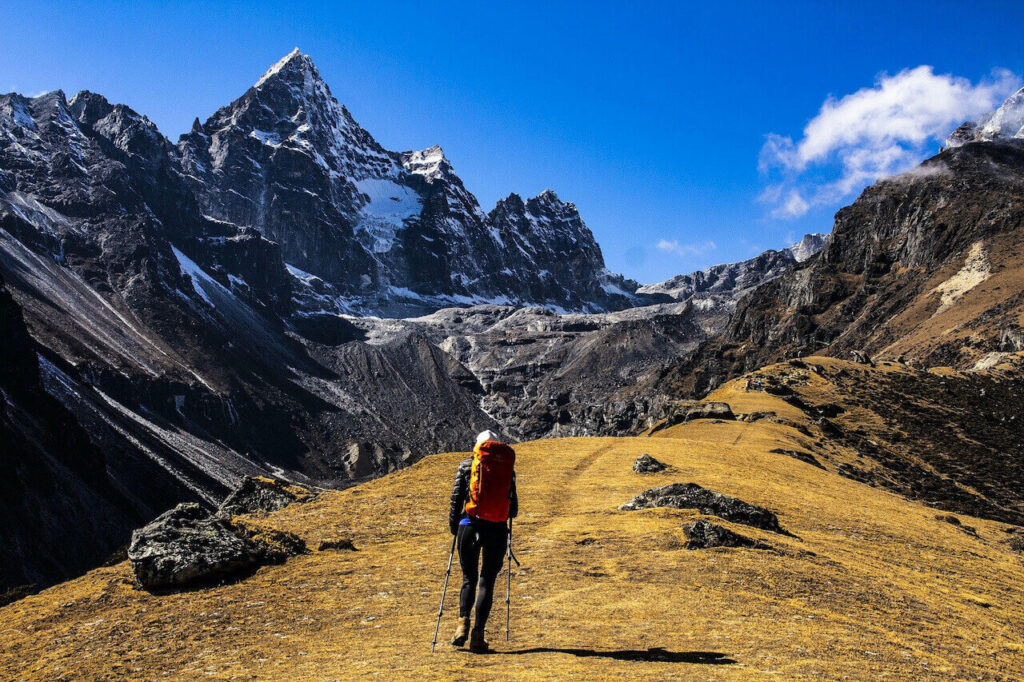
Extra. Fun Facts About Mount Everest
Mount Everest is not only a place of records and feats but also a place of fun facts that are amusing and curious. Some of these fun facts are:
- The summit of Mount Everest is not the farthest point from the center of the Earth. Due to the Earth’s bulge at the equator, the farthest point from the center of the Earth is actually Chimborazo, a volcano in Ecuador, which is about 2 km (1.2 miles) farther than Mount Everest.
- The summit of Mount Everest is not the closest point to the sun. Due to the Earth’s tilt on its axis, the closest point to the sun varies depending on the season. During the winter solstice in December, the closest point to the sun is actually Aconcagua, a mountain in Argentina, which is about 2.7 km (1.7 miles) closer than Mount Everest.
- The summit of Mount Everest has its own time zone. Due to its location on the border between Nepal and China, which have different time zones, the summit of Mount Everest has a time zone that is halfway between them. The time zone is called Nepal Standard Time plus 15 minutes or China Standard Time minus 2 hours and 15 minutes.
- The summit of Mount Everest has its own postal code. Due to its popularity as a tourist destination, the summit of Mount Everest has a postal code that is assigned by Nepal Post. The postal code is 8848, which is also the height of Mount Everest in meters.
- The summit of Mount Everest has its own internet connection. Due to its importance as a communication hub for climbers and rescuers, the summit of Mount Everest has an internet connection that is provided by China Mobile. The internet connection is based on a 3G network that was installed in 2010. The internet connection allows climbers to make phone calls, send messages, browse websites, and upload photos and videos from the summit.
It’s The Ultimate Mountain
We hope you enjoyed reading this article and learning some mind-blowing facts about Mount Everest. As you can see, Mount Everest is not just a mountain, but a symbol of human achievement, aspiration, and inspiration. It is also a place of wonder, mystery, and diversity that offers many insights into the natural and cultural world. Mount Everest is truly the ultimate mountain that deserves our respect and admiration. If you liked this article, please share it with your friends and family who might be interested in Mount Everest. You can also leave us a comment below and tell us what you think about Mount Everest or ask us any questions you might have. We would love to hear from you. Thank you for reading and stay tuned for more articles like this one.
The Broad Life introduces to you great, inspirational books for your wanderlust. They aren’t just simple travel, each book recounts the author’s journey to discover and learn many awesome things from new civilizations and places.
> READ MORE: THE BEST TRAVEL BOOKS OF ALL TIME
Note:
This post contains affiliate links from which I can earn commissions if you use services or buy products from the blog’s partners. If you love the blog, please use the services or buy the products. In that way, you give me support for the blog’s maintenance and development. I appreciate it a lot and thank you for that!
IF YOU LIKE THE MIND-BLOWING FACTS ABOUT MOUNT EVEREST AND WANT TO SAVE THEM TO READ LATER, “PIN IT” NOW!
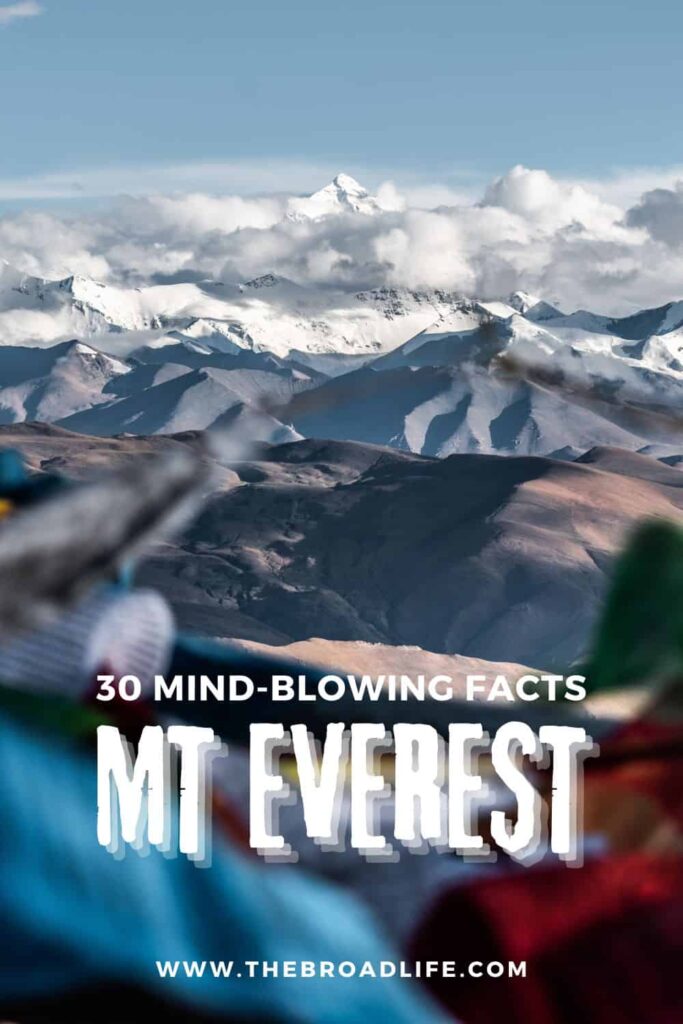
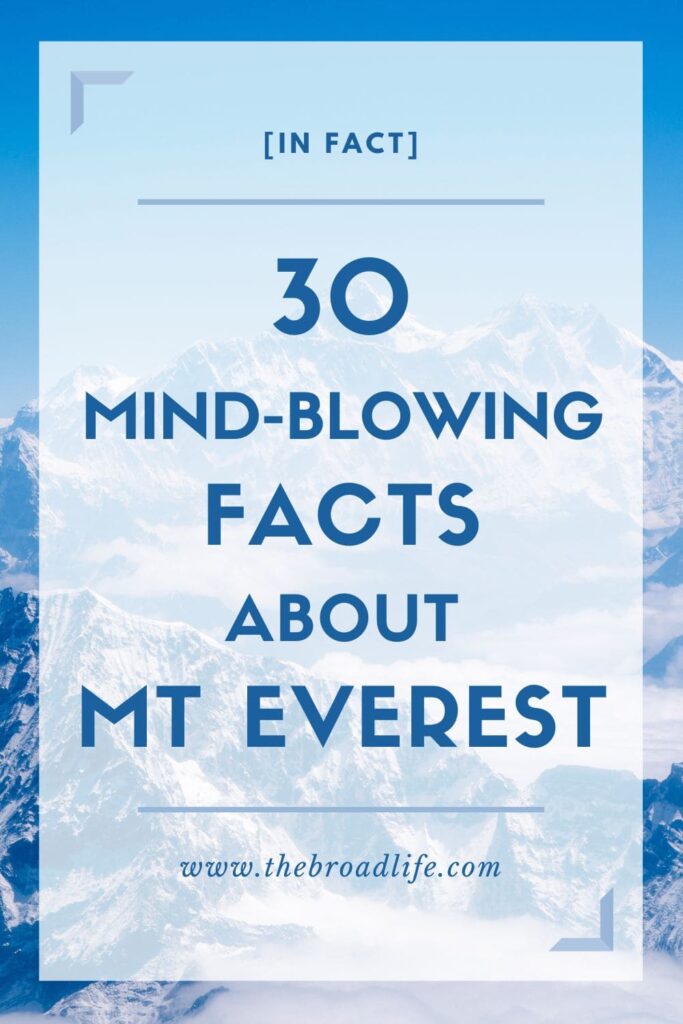
6 Comments
-
-
Sonia Seivwright
What an incredible article! I had no idea Mount Everest was more than just a mountain. It’s incredible to think about the human achievement and inspiration it represents. And the fact that it’s a place of wonder, mystery, and diversity makes it even more fascinating. I will share this article with my friends and family who love to learn about natural and cultural wonders. Thank you so much for sharing this article, and I can’t wait to read more like it!
-
Fransic verso
This is interesting, some of these are new, and never heard of them before. Thank you for sharing!


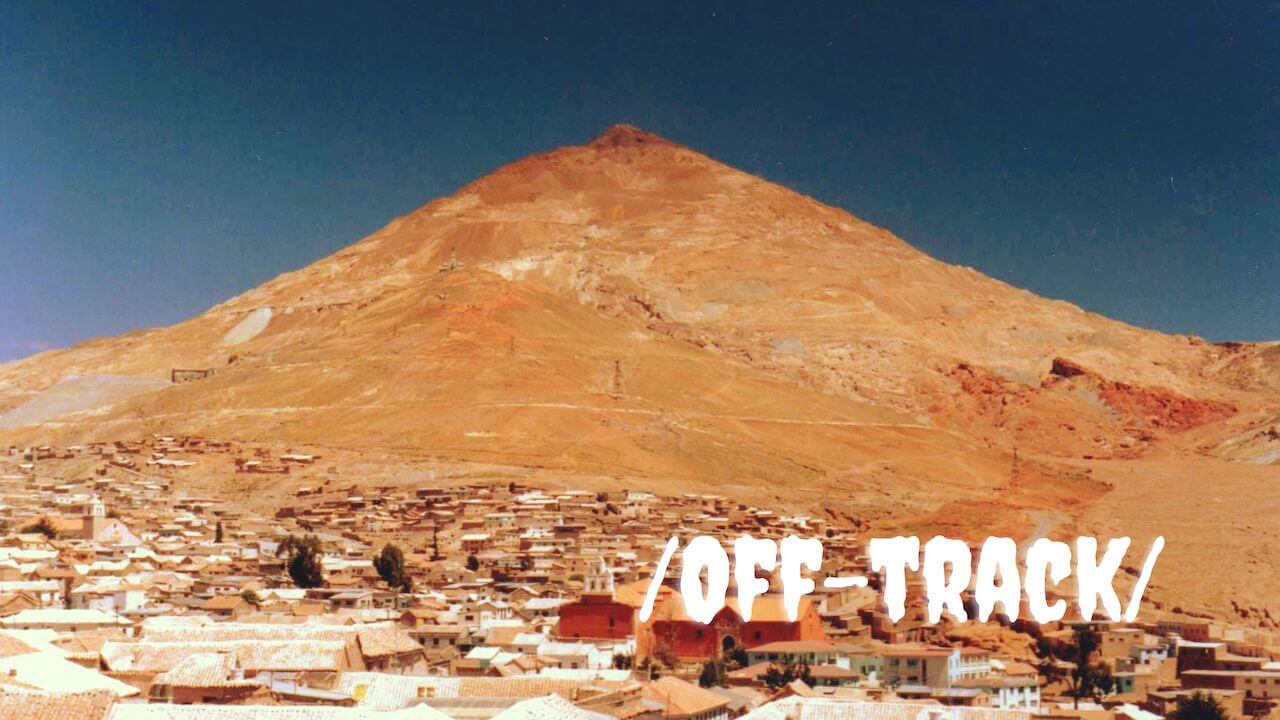

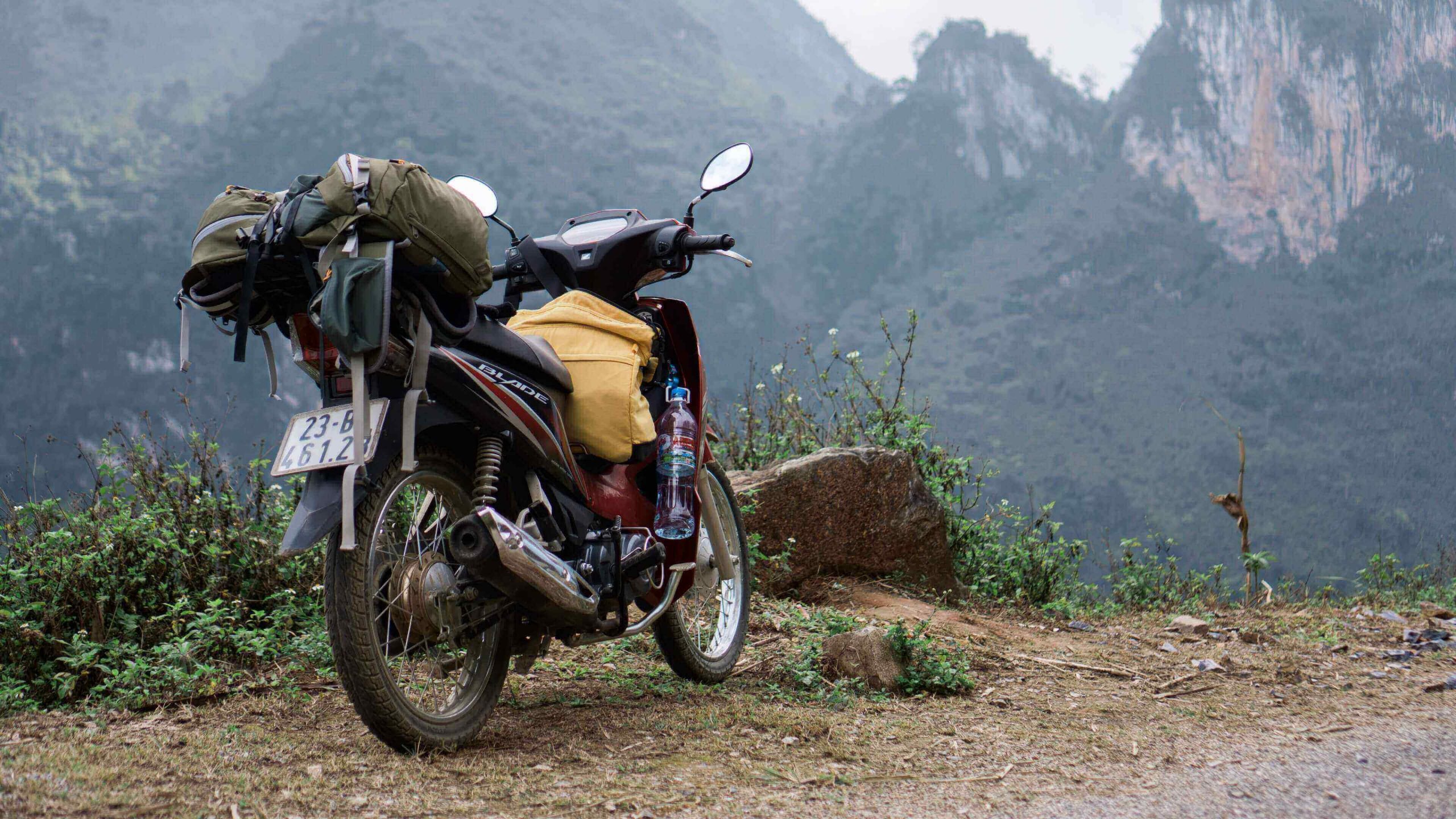
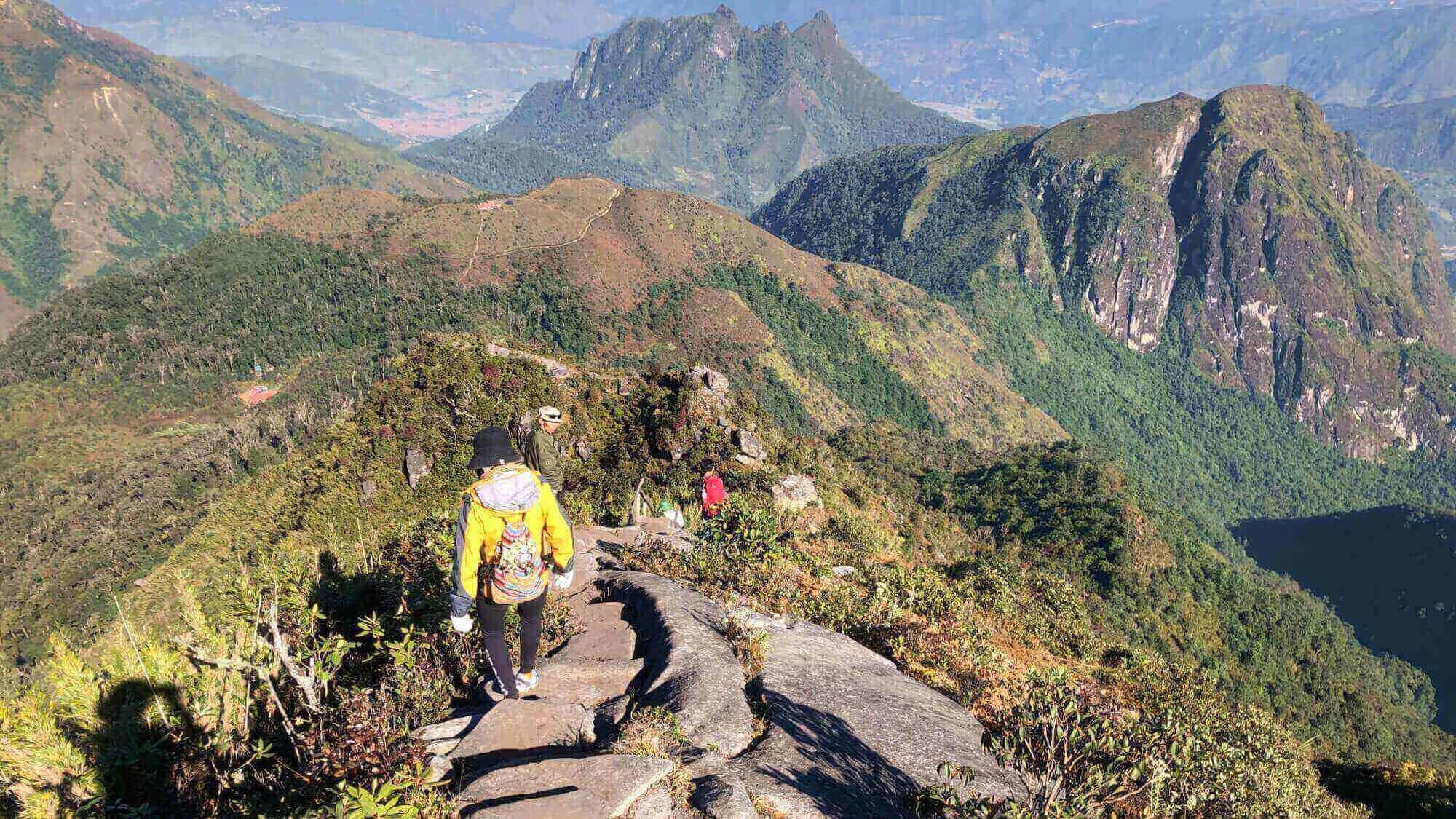
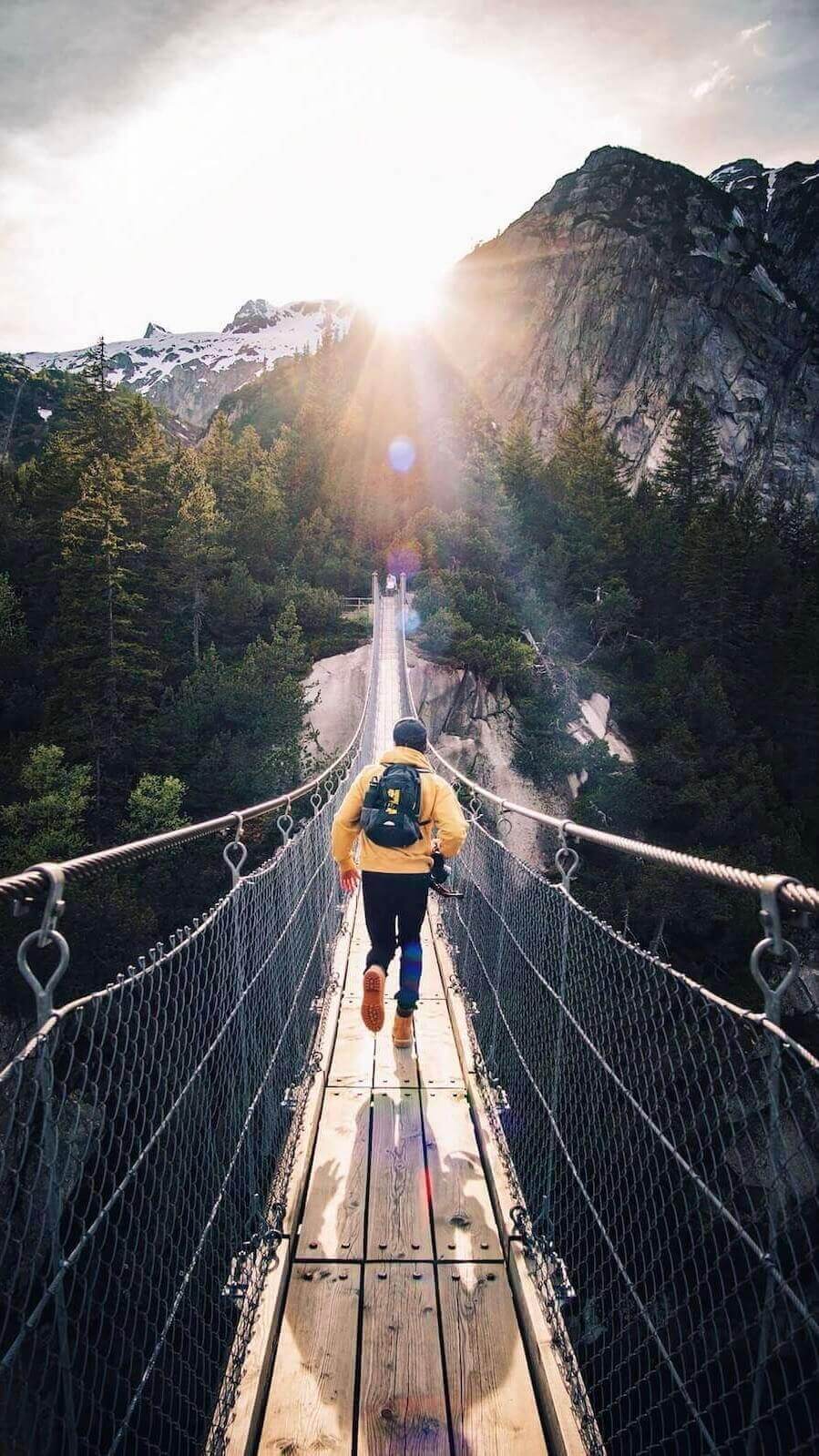
Bryan
Climbing Mt. Everest would be one of the ultimate challenges! I hate the cold, and that is one thing that keeps me away. But i am inspired that an 80 year old reached the summit. I am 56, so there is still hope!